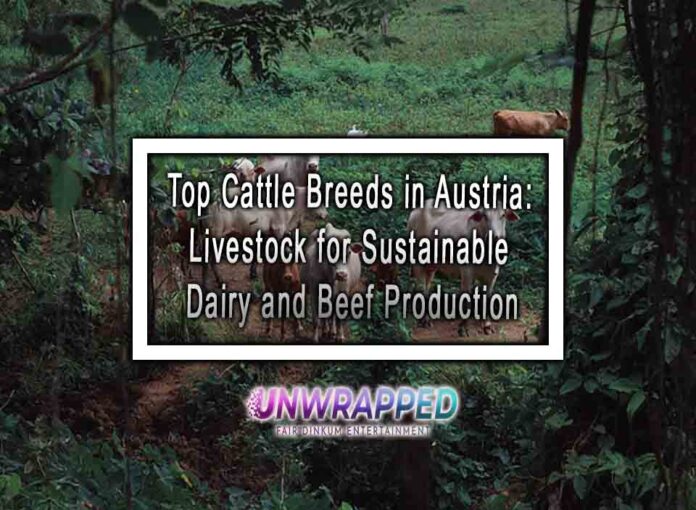Austria, with its picturesque alpine landscapes and fertile valleys, is a country deeply rooted in sustainable agriculture. Cattle farming plays a significant role in Austria’s rural economy, providing high-quality milk, meat, and environmentally sustainable farming practices. Known for its focus on animal welfare and organic production, Austria’s cattle industry relies on a mix of native and international breeds that excel in both dairy and beef production.
This article explores the top cattle breeds in Austria, their characteristics, and their contributions to sustainable farming.
Top Cattle Breeds in Austria
1. Fleckvieh (Simmental)
- Key Characteristics: Red-and-white coat, large frame, and dual-purpose productivity.
- Primary Use: Dairy and beef production.
- Fun Fact: Fleckvieh cattle are Austria’s most popular breed, known for producing high-quality milk and lean, tender beef. Their adaptability makes them ideal for both small farms and large-scale operations.
2. Brown Swiss (Braunvieh)
- Key Characteristics: Brown coat, medium-to-large size, and high milk protein content.
- Primary Use: Dairy production.
- Fun Fact: Brown Swiss cattle are prized in Austria for their long lifespans and milk rich in protein, ideal for cheese-making, particularly in the Alps.
3. Pinzgauer
- Key Characteristics: Red coat with a distinctive white stripe along the back and belly.
- Primary Use: Dual-purpose (milk and beef).
- Fun Fact: Native to Austria, Pinzgauer cattle are highly adaptable to mountain farming and are valued for their flavorful beef and high-quality milk.
4. Tyrolean Grey (Tiroler Grauvieh)
- Key Characteristics: Grey coat, small-to-medium size, and excellent grazing ability.
- Primary Use: Dairy production and conservation grazing.
- Fun Fact: A traditional breed from the Tyrol region, Tyrolean Grey cattle are renowned for their resilience in alpine pastures and their rich milk, perfect for artisanal cheese production.
5. Holstein Friesian
- Key Characteristics: Black-and-white coat, large frame, and exceptional milk yield.
- Primary Use: Dairy production.
- Fun Fact: While not native, Holstein Friesians are widely used in Austria for high-volume milk production, particularly in lowland regions with controlled farming systems.
6. Murbodner
- Key Characteristics: Brown coat, medium size, and robust build.
- Primary Use: Beef production and draft power.
- Fun Fact: This rare Austrian breed is valued for its high-quality beef and is an integral part of sustainable farming practices in Styria and Carinthia.
7. Ennstal Mountain Cattle (Ennstaler Bergschecken)
- Key Characteristics: Spotted coat, small-to-medium size, and adaptability to alpine conditions.
- Primary Use: Dairy production and conservation grazing.
- Fun Fact: These hardy cattle are primarily raised in Austria’s alpine valleys and are vital for maintaining biodiversity in high-altitude pastures.
8. Jersey
- Key Characteristics: Light brown coat, small frame, and butterfat-rich milk.
- Primary Use: Dairy production.
- Fun Fact: Jersey cows are popular in Austria for their high-fat milk, used in producing premium butter and artisanal dairy products.
9. Charolais
- Key Characteristics: White or cream-colored coat, muscular build, and efficient feed conversion.
- Primary Use: Beef production.
- Fun Fact: Charolais cattle are increasingly favored in Austria for producing lean, high-quality beef, catering to domestic and export markets.
10. Angus
- Key Characteristics: Black or red coat, medium frame, and excellent marbling in meat.
- Primary Use: Beef production.
- Fun Fact: Angus cattle are raised in Austria for their tender, premium beef, often served in gourmet restaurants.
Sustainability in Austrian Cattle Farming
- Alpine Grazing Systems: Many cattle in Austria graze in high-altitude pastures, promoting biodiversity and soil health while reducing reliance on intensive farming.
- Organic Farming: Austria has one of the highest percentages of organic farms in Europe, with cattle raised on natural pastures and without synthetic inputs.
- Dual-Purpose Breeds: Breeds like Fleckvieh and Pinzgauer support sustainable farming by providing both milk and meat, reducing the need for separate herds.
- Renewable Energy: Many Austrian farms use solar panels and biogas systems to power operations, further minimizing environmental impact.
Interesting Facts About Cattle Farming in Austria
- Cheese Tradition: Milk from breeds like Brown Swiss and Tyrolean Grey is used to produce iconic Austrian cheeses such as Bergkäse and Alpkäse.
- Rare Breeds Conservation: Austria actively works to preserve native breeds like Murbodner and Pinzgauer to maintain agricultural biodiversity.
- Cattle Drives: Seasonal cattle drives, or Almabtrieb, are a traditional event where cows are adorned with flowers and bells as they return from alpine pastures to the valley.
- Export Markets: Austrian beef and dairy products are highly regarded in European and international markets, known for their quality and sustainability.
Frequently Asked Questions
Q: Which cattle breed is most popular in Austria?
A: Fleckvieh (Simmental) is the most popular breed, known for its dual-purpose productivity and adaptability.
Q: What is the best dairy breed in Austria?
A: Brown Swiss and Tyrolean Grey are ideal for dairy production, particularly in alpine regions, due to their protein-rich milk.
Q: Are there native cattle breeds in Austria?
A: Yes, breeds like Pinzgauer, Tyrolean Grey, and Murbodner are native to Austria and are integral to sustainable farming practices.
Q: How do Austrian farmers manage cattle in alpine regions?
A: Farmers rely on hardy breeds like Tyrolean Grey and Pinzgauer, which are well-adapted to high-altitude grazing and extreme weather.
Conclusion: Sustainability Meets Tradition
Austria’s cattle farming is a harmonious blend of tradition and innovation, with native breeds like Pinzgauer and Tyrolean Grey thriving alongside international favorites like Fleckvieh and Brown Swiss. The country’s commitment to sustainability and organic farming ensures high-quality milk and beef while protecting the environment and cultural heritage.
As global demand for premium dairy and beef products grows, Austria’s cattle industry stands out for its excellence, contributing to both local and international markets. Whether it’s rich alpine milk or tender beef, Austrian cattle farming delivers unmatched quality.
See Also: Cattle Breeds in the Czech Republic: Essential Livestock for Local Farmers










